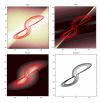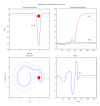Free energy, value, and attractors
- PMID: 22229042
- PMCID: PMC3249597
- DOI: 10.1155/2012/937860
Free energy, value, and attractors
Abstract
It has been suggested recently that action and perception can be understood as minimising the free energy of sensory samples. This ensures that agents sample the environment to maximise the evidence for their model of the world, such that exchanges with the environment are predictable and adaptive. However, the free energy account does not invoke reward or cost-functions from reinforcement-learning and optimal control theory. We therefore ask whether reward is necessary to explain adaptive behaviour. The free energy formulation uses ideas from statistical physics to explain action in terms of minimising sensory surprise. Conversely, reinforcement-learning has its roots in behaviourism and engineering and assumes that agents optimise a policy to maximise future reward. This paper tries to connect the two formulations and concludes that optimal policies correspond to empirical priors on the trajectories of hidden environmental states, which compel agents to seek out the (valuable) states they expect to encounter.
Figures








Similar articles
-
Reinforcement learning or active inference?PLoS One. 2009 Jul 29;4(7):e6421. doi: 10.1371/journal.pone.0006421. PLoS One. 2009. PMID: 19641614 Free PMC article.
-
Generalised free energy and active inference.Biol Cybern. 2019 Dec;113(5-6):495-513. doi: 10.1007/s00422-019-00805-w. Epub 2019 Sep 27. Biol Cybern. 2019. PMID: 31562544 Free PMC article.
-
Novelty is not surprise: Human exploratory and adaptive behavior in sequential decision-making.PLoS Comput Biol. 2021 Jun 3;17(6):e1009070. doi: 10.1371/journal.pcbi.1009070. eCollection 2021 Jun. PLoS Comput Biol. 2021. PMID: 34081705 Free PMC article.
-
A free energy principle for the brain.J Physiol Paris. 2006 Jul-Sep;100(1-3):70-87. doi: 10.1016/j.jphysparis.2006.10.001. Epub 2006 Nov 13. J Physiol Paris. 2006. PMID: 17097864 Review.
-
Where Does Value Come From?Trends Cogn Sci. 2019 Oct;23(10):836-850. doi: 10.1016/j.tics.2019.07.012. Epub 2019 Sep 4. Trends Cogn Sci. 2019. PMID: 31494042 Review.
Cited by
-
Perception and self-organized instability.Front Comput Neurosci. 2012 Jul 6;6:44. doi: 10.3389/fncom.2012.00044. eCollection 2012. Front Comput Neurosci. 2012. PMID: 22783185 Free PMC article.
-
Knowing one's place: a free-energy approach to pattern regulation.J R Soc Interface. 2015 Apr 6;12(105):20141383. doi: 10.1098/rsif.2014.1383. J R Soc Interface. 2015. PMID: 25788538 Free PMC article.
-
Nonequilibrium landscape theory of neural networks.Proc Natl Acad Sci U S A. 2013 Nov 5;110(45):E4185-94. doi: 10.1073/pnas.1310692110. Epub 2013 Oct 21. Proc Natl Acad Sci U S A. 2013. PMID: 24145451 Free PMC article.
-
Free energy and inference in living systems.Interface Focus. 2023 Apr 14;13(3):20220041. doi: 10.1098/rsfs.2022.0041. eCollection 2023 Jun 6. Interface Focus. 2023. PMID: 37065269 Free PMC article.
-
Embodied inference and spatial cognition.Cogn Process. 2012 Aug;13 Suppl 1(Suppl 1):S171-7. doi: 10.1007/s10339-012-0519-z. Cogn Process. 2012. PMID: 22843089 Free PMC article.
References
-
- Friston K, Kilner J, Harrison L. A free energy principle for the brain. Journal of Physiology Paris. 2006;100(1–3):70–87. - PubMed
-
- Sutton RS, Barto AG. Toward a modern theory of adaptive networks: Expectation and prediction. Psychological Review. 1981;88(2):135–170. - PubMed
-
- Daw ND, Doya K. The computational neurobiology of learning and reward. Current Opinion in Neurobiology. 2006;16(2):199–204. - PubMed
-
- Dayan P, Daw ND. Decision theory, reinforcement learning, and the brain. Cognitive, Affective and Behavioral Neuroscience. 2008;8(4):429–453. - PubMed
-
- Niv Y, Schoenbaum G. Dialogues on prediction errors. Trends in Cognitive Sciences. 2008;12(7):265–272. - PubMed
Publication types
MeSH terms
Grants and funding
LinkOut - more resources
Full Text Sources

